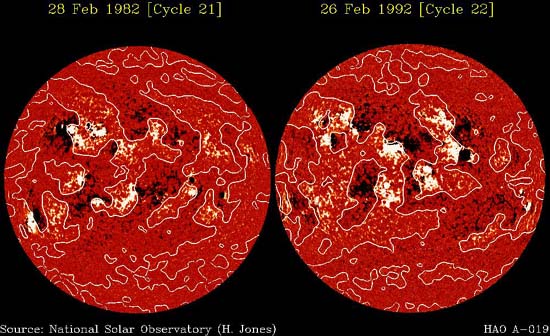
19. Hale's sunspot polarity law
This slide shows two solar magnetograms taken in the descending
phases of cycles 21 and 22. White and black correspond respectively
to positive and negative magnetic polarities
(i.e., normal magnetic field component pointing toward and away
from the observer).
The images have been rescaled and the color scale
adjusted to emphasize polarity changes
(at the expense of dynamic range). As a consequence, sunspots and
plages are not as clearly delineated as on
slide #5, but show up globally as
large regions of a given magnetic polarity. The white lines trace the
paths of magnetic neutral lines. The equator runs more or less
horizontally across each magnetogram. As noted previously (cf. slide #5),
most regions of strong magnetic fields are grouped in pairs of opposite
polarities; furthermore, at any given time
the ordering of positive/negative regions with
respect to the E---W direction (the direction of rotation, from
left to right on these images) is the same in a given hemisphere,
but is reversed from northern to southern hemispheres. This
was first determined observationally
in the first decade of the 20![]() century by G.H. Hale,
and is known as Hale's Polarity Law.
Shortly after this discovery, ongoing
studies of the magnetic polarities of sunspot pairs by Hale and
collaborators
revealed yet another intriguing pattern: from one sunspot cycle to the
next,
the magnetic polarities of sunspot pairs undergo a reversal in each
hemisphere. This polarity reversal pattern is apparent on this slide.
century by G.H. Hale,
and is known as Hale's Polarity Law.
Shortly after this discovery, ongoing
studies of the magnetic polarities of sunspot pairs by Hale and
collaborators
revealed yet another intriguing pattern: from one sunspot cycle to the
next,
the magnetic polarities of sunspot pairs undergo a reversal in each
hemisphere. This polarity reversal pattern is apparent on this slide.
Hale's Polarity Law is evidence for large-scale order underlying what would otherwise seem to be a purely stochastic phenomena. The source of these regularities is rooted in the solar dynamo, the mechanism leading to the continuous regeneration of the solar magnetic field. This involves the interaction between large-scale flows deep in the solar interior and the existing solar magnetic field, and requires the presence of the rotationally-induced Coriolis force to break the global symmetry that would otherwise characterize those fluid motions. As a discussion of the physical nature and mode of operation of the solar dynamo would entail an overly lengthy digression, we refer the interested reader to some of the textbooks listed at the end of this text. Nevertheless, it should now be apparent that in terms of the global configuration of the large-scale solar magnetic field, it takes two sunspot cycles for the same pattern of magnetic polarities to reappear. From a physical standpoint, the true length of the solar cycle is not 11 years, but rather 22 years. Yet astronomers are creatures of tradition, and solar astronomers are no exception; nearly a century after Hale's discovery of the sunspot polarity law, it remains customary to speak of the ``11 year solar cycle''.